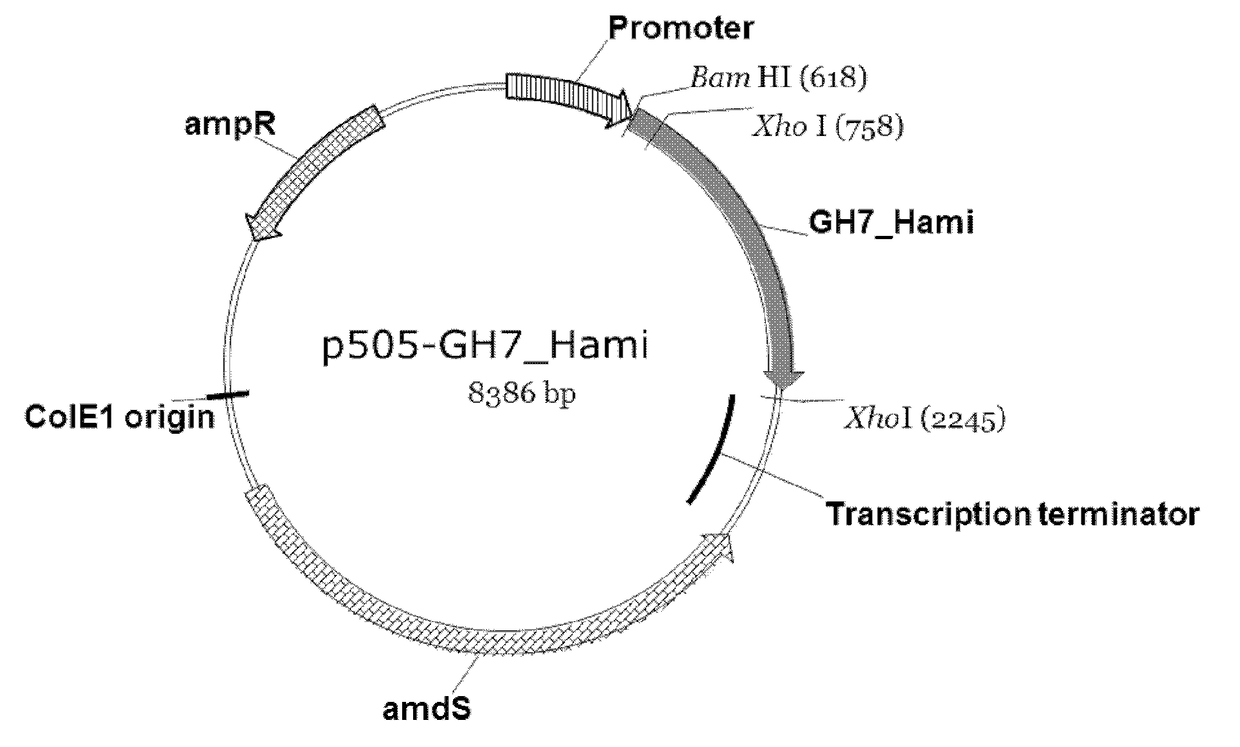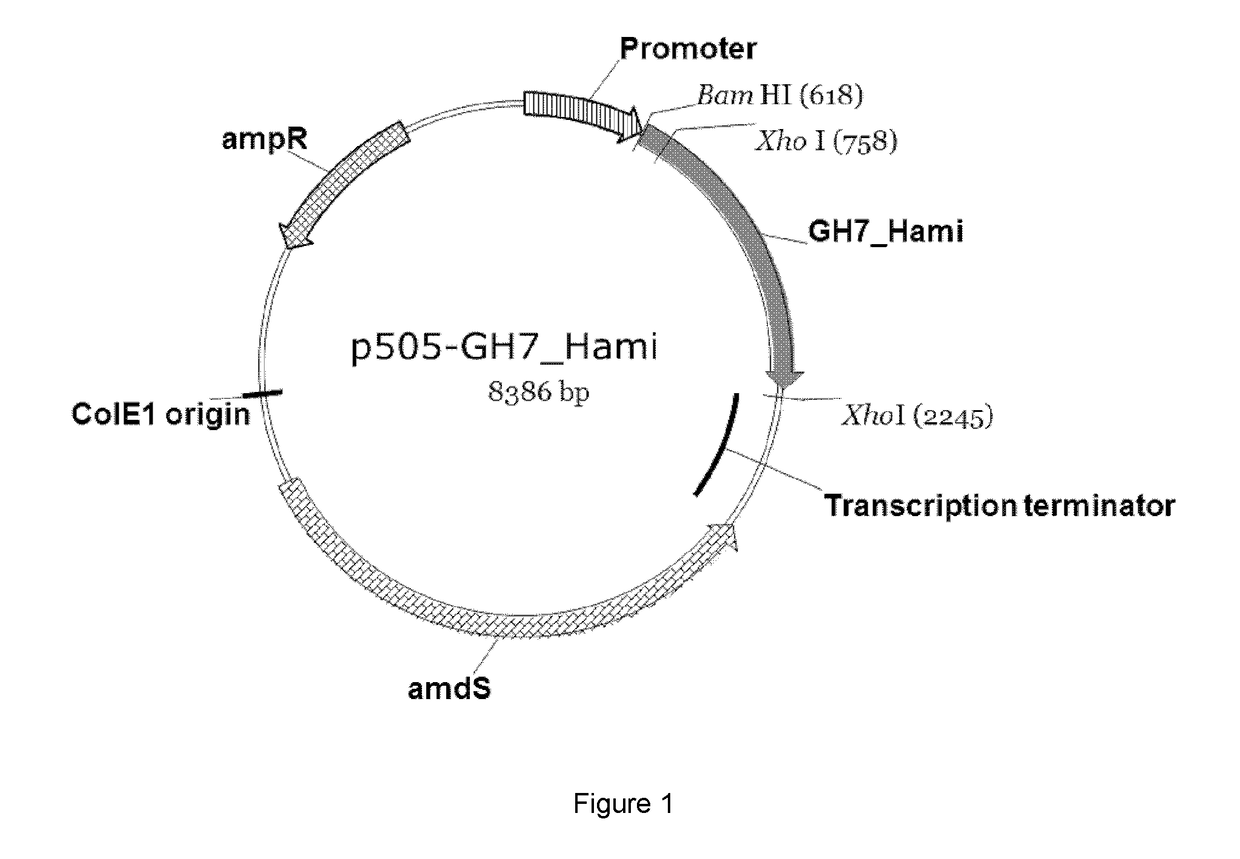Polypeptides Having Cellobiohydrolase Activity And Polynucleotides Encoding Same
a technology of polynucleotide and hydrolase activity, which is applied in the field of polypeptides, can solve the problems of undesirable accumulation of cellobiose during hydrolysis and the loss of ethanol yield
- Summary
- Abstract
- Description
- Claims
- Application Information
AI Technical Summary
Benefits of technology
Problems solved by technology
Method used
Image
Examples
example 2
quencing, Assembly and Annotation
[0374]The extracted genomic DNA samples were delivered to Fasteris (Switzerland) for genome sequencing using an ILLUMINA® HiSeq 2000 System (Illumina, Inc.). The raw reads were assembled at Fasteris using the SOAPdenovo program (Li et al., 2010, Genome Research 20: 265-72). The assembled sequences were analyzed using standard bioinformatics methods for gene identification and function prediction. GeneMark (Ter-Hovhannisyan V et al., 2008, Genome Research 18(12): 1979-1990) was used for gene prediction. Blastall version 2.2.10 (Altschul et al., 1990, J. Mol. Biol. 215(3): 403-410 and HMMER version 2.1.1 (National Center for Biotechnology Information (NCBI), Bethesda, Md., USA) were used to predict function based on structural homology. The GH7 family cellobiohydrolase polypeptides were identified directly by analysis of the Blast results. The Agene program (Munch and Krogh, 2006, BMC Bioinformatics 7: 263) and SignalP program (Nielsen et al., 1997, Pr...
example 7
on of Enzyme Compositions
[0386]A base enzyme composition designated “cellulolytic enzyme composition without cellobiohydrolase I” was prepared composed of 30% Aspergillus fumigatus GH6 cellobiohydrolase II, 10% Trichoderma reesei GH5 endoglucanase II, 10% Trichoderma reesei GH7 endoglucanase I, 3% Penicillium emersonii GH61A polypeptide, 4% Aspergillus fumigatus GH10 xylanase, 36% Aspergillus fumigatus beta-glucosidase, and 7% Aspergillus fumigatus beta-xylosidase.
[0387]The Aspergillus fumigatus GH6A cellobiohydrolase II (GEN ESEQP:AZI04854) was prepared recombinantly in Aspergillus oryzae as described in WO 2011 / 057140. The Aspergillus fumigatus GH6A cellobiohydrolase II was purified according to W / O 2012 / 122518.
[0388]The Trichoderma reesei GH5 endoglucanase II (GENESEQP:AZI04858) was prepared recombinantly according to WO 2011 / 057140 using Aspergillus oryzae as a host. The filtered broth of the T. reesei endoglucanase II was desalted and buffer-exchanged into 20 mM Tris pH 8.0 usi...
example 9
d Corn Stover Hydrolysis Assay
[0398]Corn stover was pretreated at the U.S. Department of Energy National Renewable Energy Laboratory (NREL) using 0.048 g sulfuric acid per g dry biomass at 190° C. and 25% w / w dry solids for approximately 1 minute. The water-insoluble solids in the pretreated corn stover (PCS) contained 5653.2% cellulose, 3.6% hemicellulose and 29.8% lignin. Cellulose and hemicellulose were determined by a two-stage sulfuric acid hydrolysis with subsequent analysis of sugars by high performance liquid chromatography using NREL Standard Analytical Procedure #002. Lignin was determined gravimetrically after hydrolyzing the cellulose and hemicellulose fractions with sulfuric acid using NREL Standard Analytical Procedure #003.
[0399]Prior to enzymatic hydrolysis, the PCS was ground using a COSMOS® Multi Utility Grinder (EssEmm Corporation), sieved through 420 μm sieve, and autoclaved at 121° C. for 30 minutes. The dry content of the ground and sieved PCS was 3.84%.
[0400]H...
PUM
| Property | Measurement | Unit |
|---|---|---|
| Fraction | aaaaa | aaaaa |
| Fraction | aaaaa | aaaaa |
| Fraction | aaaaa | aaaaa |
Abstract
Description
Claims
Application Information
 Login to View More
Login to View More - R&D
- Intellectual Property
- Life Sciences
- Materials
- Tech Scout
- Unparalleled Data Quality
- Higher Quality Content
- 60% Fewer Hallucinations
Browse by: Latest US Patents, China's latest patents, Technical Efficacy Thesaurus, Application Domain, Technology Topic, Popular Technical Reports.
© 2025 PatSnap. All rights reserved.Legal|Privacy policy|Modern Slavery Act Transparency Statement|Sitemap|About US| Contact US: help@patsnap.com



